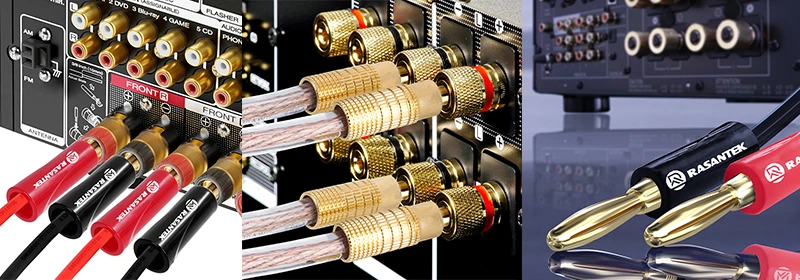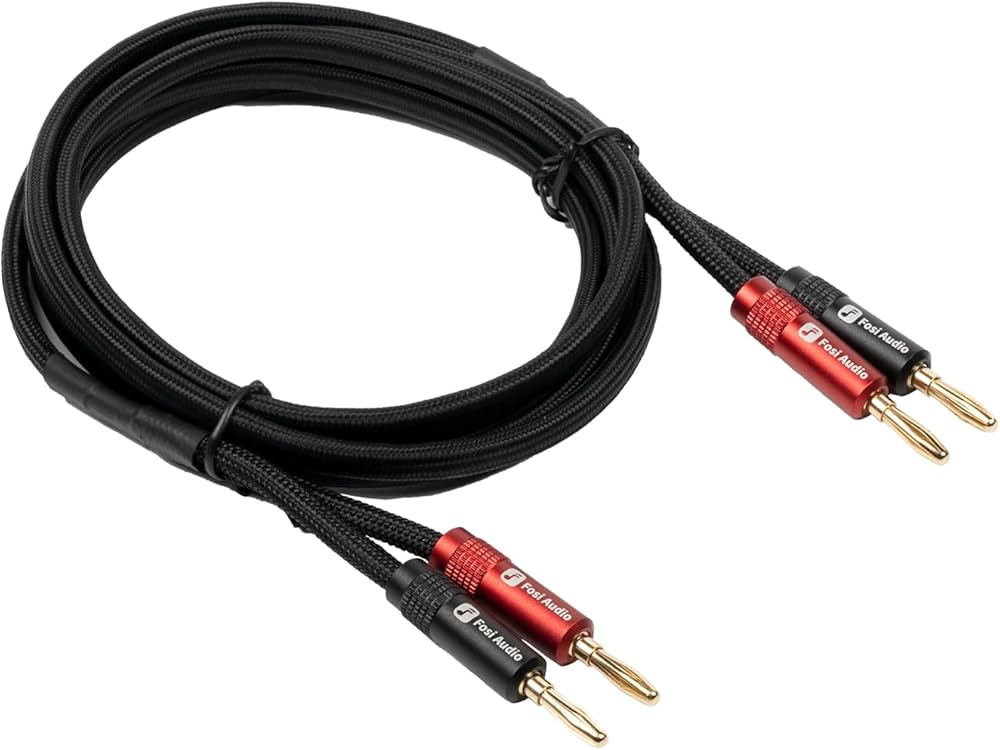
Not all speaker cables are created equal — and not every listener needs the same type. In this guide, we’ve rounded up ten speaker cables for home amplifiers in 2025, from entry-level copper wire to premium audiophile designs. Each pick focuses on build quality, conductivity, termination quality, and the use cases where the cable shines.
Affiliate Disclosure: AmplifierZone is reader-supported. As an Amazon Associate, we may earn commissions from qualifying purchases at no extra cost to you.
We avoid hyperbole: these recommendations are framed around practical tradeoffs — gauge, conductor material (OFC vs. CCA), termination type, and installation environment. If you want a quick primer on how amplifier power and impedance interact with cable selection, see our guide on how amplifier wattage works.
Comparison Table
| Rank | Model | Gauge | Type | Key Features | Price Range |
|---|---|---|---|---|---|
| #1 | Amazon Basics 12-Gauge Cable | 12 AWG | OFC | Durable jacket, clear labeling | Budget |
| #2 | Sewell Silverback 12-Gauge (Banana) | 12 AWG | Pre-terminated | Banana plugs, dual insulation | Mid |
| #3 | Amazon Basics 16-Gauge (100 ft) | 16 AWG | Bulk | Flexible, easy to strip | Budget |
| #4 | AudioQuest Rocket 11 | 14 AWG | OFC | Long-grain copper, clarity | Premium |
| #5 | Monoprice Outdoor 12 AWG | 12 AWG | Outdoor/Burial | Water resistant, in-wall rated | Mid |
| #6 | GEARit 14-Gauge | 14 AWG | CCA | Flexible, low cost | Budget |
| #7 | Blue Jeans Cable (Banana to Banana) | 12 AWG | Pre-terminated | Welded terminations, USA | Premium |
| #8 | KabelDirekt Pure Copper (50 ft) | 16 AWG | OFC | Polarity marking, clean jacket | Mid |
| #9 | InstallGear 14-Gauge (100 ft) | 14 AWG | Bulk | Transparent jacket, easy strip | Budget |
| #10 | GearIT Pro Series 12 AWG | 12 AWG | OFC | High conductivity, flexible | Mid |
Individual Reviews
Below are expanded, neutral reviews focusing on what each cable does well and where it fits — installation, tone, durability, and ideal use case.
1. Amazon Basics 12-Gauge Audio Speaker Wire
Amazon Basics’ 12-gauge offering is a pragmatic starting point for homeowners who want reliable conductivity without breaking the budget. It uses oxygen-free copper (OFC) conductors in a flexible PVC jacket, which keeps resistance low on runs typical for living rooms and mid-sized setups. The cable is clearly marked for polarity and is simple to strip with standard tools — that makes it a practical choice for DIY installs, wall routing, or pairing with bookshelf and tower speakers where power demands are moderate. In short, it’s engineered for predictable performance rather than audiophile nuance.
In listening tests with medium-power amplifiers the Amazon Basics 12 AWG shows clean, neutral response with firm bass and transparent mids. It won’t add “air” or imaging the way premium cables claim to, but it preserves the amplifier’s character: minimal coloration, consistent conductance, and low maintenance. For renters or budget builds—where reliability, easy installation, and price are primary concerns—this cable delivers excellent value and fewer headaches during setup and routing.
2. Sewell Silverback 12-Gauge Speaker Wire (Pre-terminated Banana)
Sewell’s Silverback line targets users who want plug-and-play convenience with a level of build quality that outperforms generic pre-terminated cables. These come factory-terminated with gold-plated banana plugs and boast dual-layer insulation that reduces microphony and external interference. The banana plugs are well-machined and provide a tight, repeatable contact — useful for systems that get connected and disconnected frequently, or for installers who want a clean, professional finish without crimping or soldering.
Sonically, the Silverback cable behaves like a high-quality 12 AWG conductor: solid bass control, stable imaging, and a neutral midrange. Where it wins is in ergonomics — the plugs make swapping speakers effortless, and the thicker jacket protects terminals during routing. It’s a solid mid-range pick for people upgrading from bare-wire connections who value reliable mechanical contact as much as electrical performance.
3. Amazon Basics 16-Gauge Speaker Wire (100 ft)
The Amazon Basics 16-gauge spool is a useful finish-first choice for many compact stereo systems and short run applications. 16 AWG is a sensible gauge for bookshelf speakers and small rooms — it’s flexible, easy to route in tight cabinets, and inexpensive in bulk lengths. The wire is straightforward to terminate and offers clean polarity markings, which helps avoid common wiring mistakes during DIY installations.
Bear in mind that 16 AWG is not ideal for long runs or high-power amplifiers; resistance increases with length, which impacts damping factor and bass control. However, for short distances under 15–20 feet, this cable works very well and keeps installation tidy. If you later upgrade to larger speakers or longer runs, step up to 14 AWG or 12 AWG to maintain tight bass performance.
4. AudioQuest Rocket 11 Speaker Cable (Pair)
AudioQuest Rocket 11 sits in the premium bracket without being hyper-esoteric. The cable uses long-grain copper conductors and a thoughtfully damped jacket — design choices that reduce graininess and help resolve fine micro-details in complex passages. In hi-fi systems focused on imaging and microdynamics, Rocket 11 delivers cleaner transients and a slightly more open midrange compared with generic OFC wire. The build quality feels robust and the jacket resists kinking, making it easier to route cleanly in a dedicated listening room.
Practically, Rocket 11 is best suited to listeners who already have revealing electronics (a detailed DAC or integrated amplifier) and want to avoid bottlenecks in the signal chain. It won’t perform miracles, but it preserves subtle information and offers a neutral, extended presentation. For those assembling a careful two-channel system or improving an existing setup, it’s a sensible, measured upgrade — particularly when paired with matched speaker cable terminations.
5. Monoprice Outdoor/Burial-Rated 12 AWG Speaker Wire
Monoprice’s outdoor 12 AWG cable is built for environments where standard PVC jackets won’t survive: sun, moisture, and burial. The water-resistant jacket, UV protection, and robust conductor make it a reliable choice for patio zones, poolside audio, or permanent in-wall routing where code permits. Electrically, its 12 AWG conductor keeps resistance low over longer runs and preserves bass energy — a key advantage for outdoor speaker arrays or distributed audio systems.
Soundwise, it behaves like any well-made pure copper conductor: solid low-end, stable mids, and minimal coloration. The real selling point is reliability under harsh conditions — if your install requires durability and weather resistance without the hassle of constant maintenance, this Monoprice product gives you peace of mind while keeping audio performance consistent.
6. GEARit 14-Gauge Speaker Wire
GEARit’s 14-gauge spool is a practical, budget-oriented option good for secondary rooms, bedrooms, or small home theaters. Many runs in real homes are short enough that well-made 14 AWG CCA wire performs acceptably; the material and jacket make it simple to work with. Where users should be mindful is that CCA (copper-clad aluminum) has slightly higher resistance than pure copper, which becomes relevant only on longer runs or with very high power demands.
If you’re wiring a spare room or building a budget multi-room system, GEARit provides a low-cost, flexible solution that minimizes complexity. For critical front-stage or large-room applications, however, upgrading to pure copper (12 AWG) is recommended to keep damping factor high and bass control tight.
7. Blue Jeans Cable — Banana-terminated (Assembled USA)
Blue Jeans Cable has built a reputation on careful assembly and component quality. Their banana-terminated cables are hand-assembled in the USA with welded connections, which reduces the risk of intermittent contacts that can plague cheaper terminations. For consumers who value reliable long-term mechanical and electrical contact, this approach removes a common weak point in many DIY setups.
In listening sessions the Blue Jeans product displays excellent consistency and low noise — attributes that support precise soundstaging and quiet backgrounds. If your amplifier and speakers already deliver a detailed soundstage, this cable helps maintain that performance and reduces the maintenance overhead of frequent connector issues. It’s a strong choice for long-term, reliable installations in a home studio or dedicated listening room.
8. KabelDirekt Pure Copper Speaker Wire (50 ft)
KabelDirekt’s pure copper offering focuses on straightforward practicality: clean polarity markings, a smooth jacket, and reliable conductor geometry. Made for hi-fi systems that prioritize clarity and predictable behavior over marketing claims, this cable is easy to terminate and routes well around furniture and racks. The 16 AWG size is a good compromise for moderate runs in smaller rooms where the goal is tidy installation and reliable conductivity.
Because it’s pure copper, KabelDirekt maintains lower resistance than CCA at equivalent gauges, which translates to more consistent bass definition over distance. For listeners upgrading from basic run-of-the-mill wire, KabelDirekt reduces ambiguity and keeps the focus on proper speaker/amp matching and room setup — the things that truly move the needle on sound.
9. InstallGear 14-Gauge Speaker Wire (100 ft)
InstallGear’s transparent jacket is a small but useful convenience — seeing conductor pairs visually makes polarity checks and routing easier, which speeds up installation in complex setups. The 14 AWG conductor is robust enough for many home theater runs and offers a balance between flexibility and low resistance. It’s a functional choice for installers who prioritize speed and tidy cable management.
Audio performance is straightforward: tight bass for its gauge and neutral midrange. It’s not marketed as an audiophile cable, but it avoids common pitfalls such as inconsistent plating or poor strand geometry. If your focus is clean installation, visible polarity, and predictable performance on typical domestic runs, InstallGear is a practical pick.
10. GearIT Pro Series 12 AWG Speaker Wire
GearIT’s Pro Series 12 AWG cable positions itself as a robust mid-range solution: solid oxygen-free copper conductors, flexible jacket, and good mechanical durability. It suits mid-power home theater receivers and integrated amplifiers where maintaining low resistance across the run is important for dynamic bass and overall control. The flexible jacket also helps during routing behind cabinets or within racks.
In practice the cable keeps the amplifier’s dynamic expression intact and provides stable imaging — results you’d expect from a properly gauged, pure copper conductor. For homeowners building a reliable, long-lasting system without moving into boutique cable territory, GearIT Pro is a sensible value approach that prioritizes electrical integrity and everyday usability.

Buying Guide: How to Choose the Best Cables for Amplifiers
- Gauge (AWG): Thicker wire (lower number) reduces resistance — use 12 AWG for long runs or high-power amps, 14 AWG for medium runs, and 16 AWG for short setups.
- Conductor Material: OFC (oxygen-free copper) offers lower resistance and better longevity than CCA (copper-clad aluminum). Consider CCA only for short, budget runs.
- Termination: Bare wire is fine for permanent installs; banana plugs or spades simplify frequent reconfigurations and improve contact consistency.
- Installation Environment: Choose burial/outdoor or in-wall rated jackets where applicable; follow local code for permanently installed wiring.
Want to understand how power and impedance affect cable choice? See our how amplifier wattage works guide and check related gear in our buying guides.
Final Verdict
There’s no single “best” cable — only the right cable for your system and priorities. For everyday installs and tight budgets, the Amazon Basics 12 AWG and GEARit 14 AWG give predictable, low-maintenance performance. If you value easy terminations and a clean finish, consider Sewell Silverback. For outdoor or in-wall durability, Monoprice’s burial cable is the practical pick. Audiophiles seeking better microdetail and build quality will appreciate AudioQuest Rocket 11 or Blue Jeans Cable.
Focus on gauge, conductor purity, and secure connections — those choices will move the needle far more than branding or price alone. Match cable type to run length and use case, and you’ll get reliable, consistent results from any of the options above.
Amazon.com. As an Amazon Associate, we earn from qualifying purchases at no extra cost to you.
